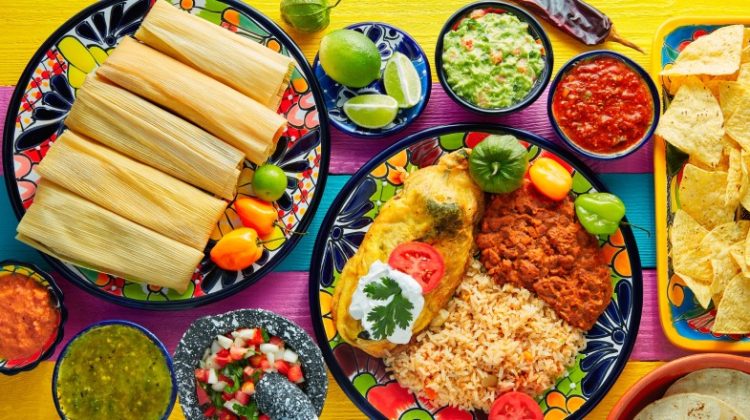Introduction to the Diverse Flavors of Mexican Cuisine
Mexican cuisine is an explosion of color, flavor, and history that has captivated food lovers across the globe. It is a cuisine that has been shaped by centuries of tradition, indigenous cultures, and external influences, creating a dynamic and diverse food landscape. It is more than just food—it is a cultural expression, a way of life, and a deep reflection of Mexico’s rich history and geography. From the bustling streets of Mexico City to the quaint villages of Oaxaca, Mexican cuisine offers a window into the soul of its people.
The food of Mexico is diverse, influenced by the country’s varied landscapes, climates, and the many cultures that have left their mark throughout history. The cuisine brings together indigenous ingredients and flavors, European influences from Spain, and African and Asian spices and techniques. At the heart of this culinary tradition are core ingredients like corn, chili, beans, and squash, which have shaped the foundation of Mexican food for thousands of years. These ingredients are integral to understanding the rich cultural history of Mexico and its people.
Mexican cuisine is also incredibly regional, with each state and city offering distinct flavors, preparation methods, and cooking techniques. From the fiery heat of chilies in the north to the tropical sweetness of fruit and seafood in the coastal regions, Mexican food is as diverse as the country itself. Exploring Mexican cuisine is not only about tasting its food—it’s about understanding its cultural significance and its role in everyday life.
Cultural Significance of Ingredients like Corn, Chili, and Beans
At the heart of Mexican cuisine lies a trio of ingredients that have not only shaped the flavors of the food but also have a profound cultural significance. These are corn (maíz), chili (chile), and beans (frijoles)—ingredients that date back to pre-Columbian times and have been central to the diet and identity of the Mexican people for millennia.
- Corn (Maíz)
Corn is perhaps the most fundamental and symbolic ingredient in Mexican cuisine. It was cultivated by indigenous peoples long before the arrival of Europeans, and it remains central to the Mexican diet today. Corn is not only the base for many dishes but also plays a critical role in Mexican culture and mythology. It is used to make tortillas, tamales, and even drinks like atole and pozole. The versatility of corn, from its ground form in masa (corn dough) to its presence in whole kernels, is one of the defining features of Mexican cuisine.
Corn is also deeply intertwined with Mexico’s cultural identity. It is a symbol of the nation’s agricultural roots and has been celebrated in rituals, festivals, and ceremonies for centuries. The ancient Mexican god of maize, Cinteotl, highlights the sacred nature of corn in indigenous culture. Even today, many Mexicans believe that corn is a gift from the gods, and it is revered in daily life and spiritual practices.
- Chili (Chile)
Chili peppers are another essential ingredient in Mexican cuisine, contributing heat, flavor, and depth to dishes. Mexico is home to hundreds of varieties of chili peppers, and each variety adds its own unique flavor profile to the dishes it complements. Whether dried or fresh, chilies are used to add spice, color, and richness to sauces, stews, and salsas. Famous chili varieties include habanero, jalapeño, chipotle, ancho, and pasilla.
Chili peppers are integral to the creation of moles (complex sauces), salsas, and adobos (marinades), and their use can vary greatly from region to region. The use of chili also has deep cultural and symbolic meaning in Mexican history. It represents the connection between the people and the earth, often seen as a vital source of sustenance and identity.

- Beans (Frijoles)
Beans are another staple of Mexican cuisine and have been a primary source of protein in the Mexican diet for centuries. Indigenous groups such as the Aztecs and Maya relied heavily on beans for sustenance, and today, beans remain an essential part of everyday meals. Black beans, pinto beans, and red beans are commonly used, and they often accompany tortillas, rice, and meats.
Beans are not just a source of nutrition but are also a cultural symbol of community and tradition. They are often served at family meals, festive gatherings, and are frequently incorporated into celebrations and rituals, underscoring their significance in Mexican life.
Traditional Dishes to Try: Mole, Tacos, and Tamales
Mexican cuisine is famous for its rich and varied dishes, and three of the most iconic foods that reflect the heart of Mexican cooking are mole, tacos, and tamales. These dishes not only showcase the diverse flavors of Mexico but also offer insight into the cultural significance of food in the country.
- Mole
Mole is a complex, multi-layered sauce that exemplifies the depth and intricacy of Mexican cuisine. The dish itself has roots in pre-Hispanic Mexico, with different varieties of mole being created by indigenous groups long before the Spanish arrived. Today, mole poblano, originating from Puebla, is the most famous version, consisting of a blend of chilies, spices, chocolate, nuts, and seeds, creating a rich, earthy flavor.
Mole is typically served with chicken, turkey, or pork, and it is a dish often prepared for special occasions, holidays, and festivals. The preparation of mole is a time-consuming process, often involving hours of grinding, mixing, and simmering to develop the perfect balance of flavors. The complexity of mole makes it a true representation of the fusion between indigenous ingredients and European influences.
- Tacos
Tacos are perhaps the most famous Mexican food worldwide, and their versatility is unmatched. A taco is a simple yet flavorful dish consisting of a tortilla filled with various types of meat, seafood, vegetables, or beans, and topped with an array of salsas, onions, cilantro, and lime. Tacos are consumed daily by Mexicans, with countless regional variations across the country.
From tacos al pastor (pork cooked on a spit) in Mexico City to tacos de pescado (fish tacos) along the coast, each taco reflects the region’s history, geography, and ingredients. Tacos have become a symbol of Mexican street food and are a key part of the country’s culinary culture, offering a quick, affordable, and delicious way to enjoy authentic Mexican flavors.
- Tamales
Tamales are another traditional Mexican dish that has deep roots in indigenous culture. Tamales are made from masa (corn dough) and are filled with a variety of ingredients, including meats, vegetables, and chilies. They are then wrapped in corn husks or banana leaves and steamed. The preparation of tamales is often a communal activity, with families gathering to prepare and share them for special occasions and holidays.
Tamales are traditionally served during celebrations like Christmas, Dia de los Muertos (Day of the Dead), and Las Posadas (a Christmas tradition), making them a significant part of Mexican culture and festivals. The process of making tamales is also symbolic, as it brings people together and highlights the importance of family and community.
Food’s Role in Mexican Festivals and Customs
Mexican food plays a central role in the country’s festivals and customs. Throughout the year, Mexico celebrates a wide variety of cultural and religious holidays, and food is often at the center of these celebrations. Whether it’s the vibrant Dia de los Muertos (Day of the Dead) festival, the national Independence Day celebrations, or the family-centered Navidad (Christmas), food helps to mark these special moments in Mexican culture.
One of the most significant festivals in Mexican cuisine is Cinco de Mayo, which celebrates Mexico’s victory over France in the Battle of Puebla. During this festival, people gather to enjoy traditional foods like mole poblano, tacos, and tamales, reflecting the deep cultural heritage and pride associated with Mexican cuisine.
Best Destinations for Food Lovers: Mexico City, Oaxaca, Guadalajara
For food lovers eager to explore the best of Mexican cuisine, there are a few destinations that stand out for their culinary offerings:
- Mexico City
Mexico City, the country’s capital, is a bustling metropolis with a rich food scene that blends traditional dishes with modern innovations. The city is home to street vendors, fine dining restaurants, and iconic markets like Mercado de La Merced and Mercado de Coyoacán, where you can try everything from tacos al pastor to tamales and fresh juices. - Oaxaca
Oaxaca, known as the culinary capital of Mexico, is a must-visit for anyone passionate about food. The region is famous for its distinctive mole varieties and the abundance of indigenous ingredients. Oaxacan food is deeply rooted in tradition, and visitors can enjoy dishes like tlayudas, quesillo (Oaxacan cheese), and mole negro. - Guadalajara
Guadalajara, located in the Jalisco region, is the birthplace of tequila and is known for its delicious torta ahogada (a pork sandwich soaked in a spicy sauce). The city’s vibrant food culture blends indigenous and Spanish influences, offering dishes like birria (a slow-cooked meat stew) and tacos de barbacoa.
Conclusion
Mexican cuisine is a true reflection of the country’s diverse cultures, histories, and traditions. From the foundational ingredients of corn, chili, and beans to the intricate flavors of mole and tamales, the food of Mexico tells a story of resilience, innovation, and community. Whether you’re enjoying tacos on a street corner in Mexico City, savoring mole in Oaxaca, or trying tamales at a family gathering, Mexican food is a vibrant celebration of culture, family, and tradition.





















